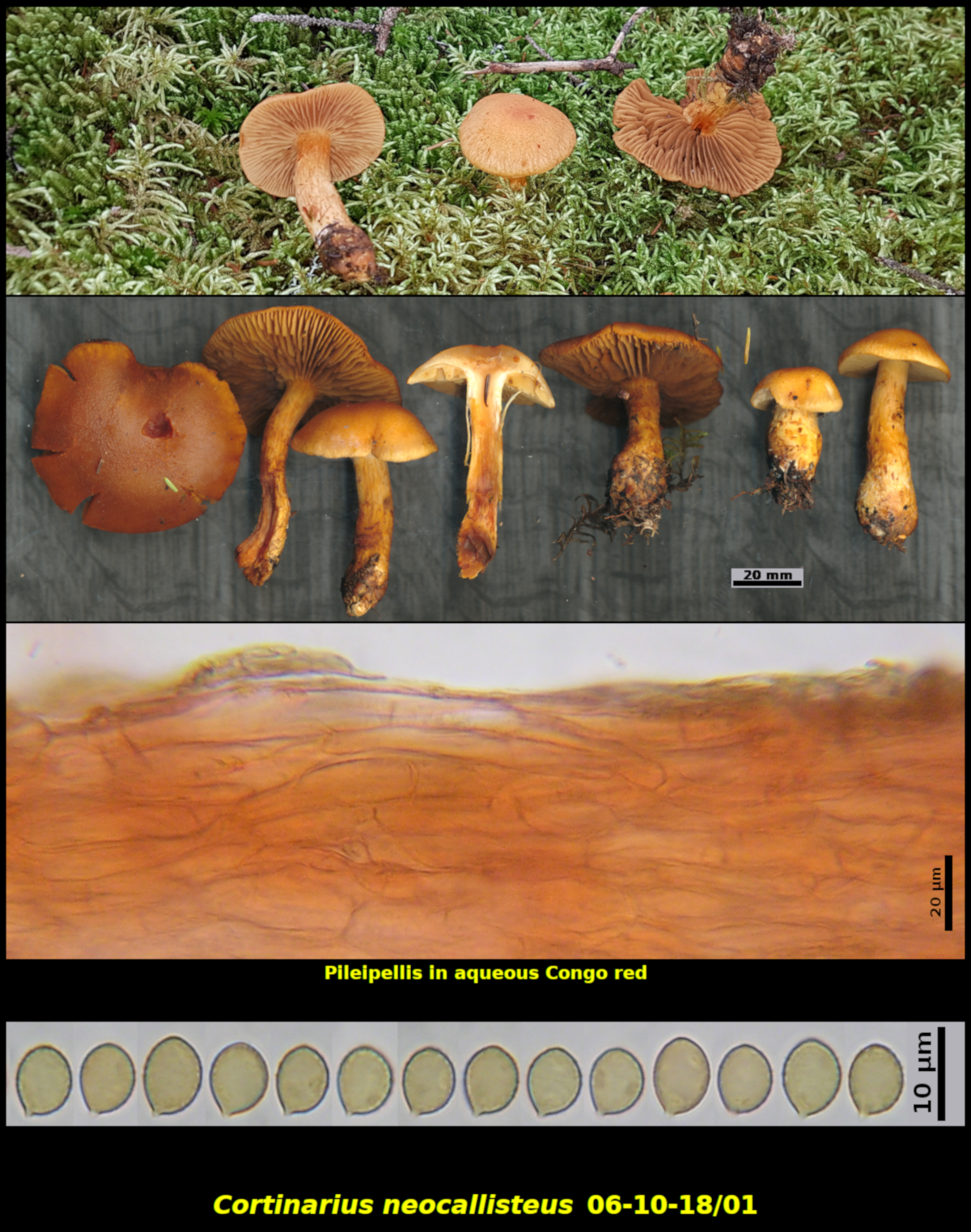Fleshy Fungi of New Brunswick >>
Cortinarius neocallisteus
Cortinarius neocallisteus Kranab., Ammirati, Liimatainen & Niskanen

Gregarious (many) in a deep carpet of Pleurozium and Sphagnum mosses, associated with Abies balsamea and Picea rubens – 1.0 km west of Little Lepreau, Charlotte Co., New Brunswick (06-10-18/01).
Pileus convex to conical at first, expanding to broadly convex at maturity, with a low broad umbo in some, moist, finely appressed-scaly, with scales becoming obscure at full expansion, bright orange to bright greyish orange (HSV35:70:90-100), with scales slightly darker, darkening slightly in KOH, hygrophanous, 45-63 mm in diameter. Stipe nearly equal to clavate, yellow (HSV50;50:100) at the apex and probably throughout as a ground colour, streaked or overlain with reddish orange (HSV20;70:80-90) fibrils, dry, 55-65 X 8-12 mm. Lamellae yellow (HSV50;20-30:100), subclose, adnexed, not marginate. Cortina sparse, yellow. Flesh yellow (HSV50;20:100) in most of the pileus and in the upper part of the stipe, reddish orange (HSV20:60:80-90) in the centre of the pileus and lower parts of the stipe, darkening slightly in KOH, with a nondescript mushroom odour
Basidiospores bright orange brown in spore print, broadly ellipsoidal, finely but conspicuously roughened, darkening slightly in Melzer’s Solution, 7.0-8.4 x 5.7-6.4 µm, Q = 1.15-1.35 (average[34]: 7.5 x 6.0 µm, Q = 1.25).Basidia 4-spored, clamped at the base. Pileipellis a cutis of encrusted light brown hyphae, with a subcutis of broader hyphae.
Cortinarius neocallisteus can be difficult to distinguish from C. limonius. Generally, C. limonius has a rather abundant yellow universal veil that can adhere thickly to the margin of the pileus us a yellow zone and can be more flocculose on the stipe, while the veil of C. neocallisteus is usually less conspicuous. In addition, the stipes of Cortinarius limonius tends to be tapered, while those of C. neocallisteus are often bulbous at the base. Cortinarius callisteus, a very similar species found commonly in Europe and only rarely in North America, has a peculiar odour variously described as ozone, hot iron or a snuffed-out candle.
Although described only recently from British Columbia, C. neocallisteus has now been reported from several localities in eastern Canada, including Quebec and Newfoundland. A recent record of C. neocallisteus from New Brunswick (Malloch 20-10-19/04) was reported on iNaturalist as Observation 34743605 and cited as Kriebel Herb. (PUL) No. F26637. That collection was sequenced as part of the MycoBlitz program and its identity confirmed. The main part of that collection is in the New Brunswick Museum.
Photograph: D. Malloch (06-10-18/01).